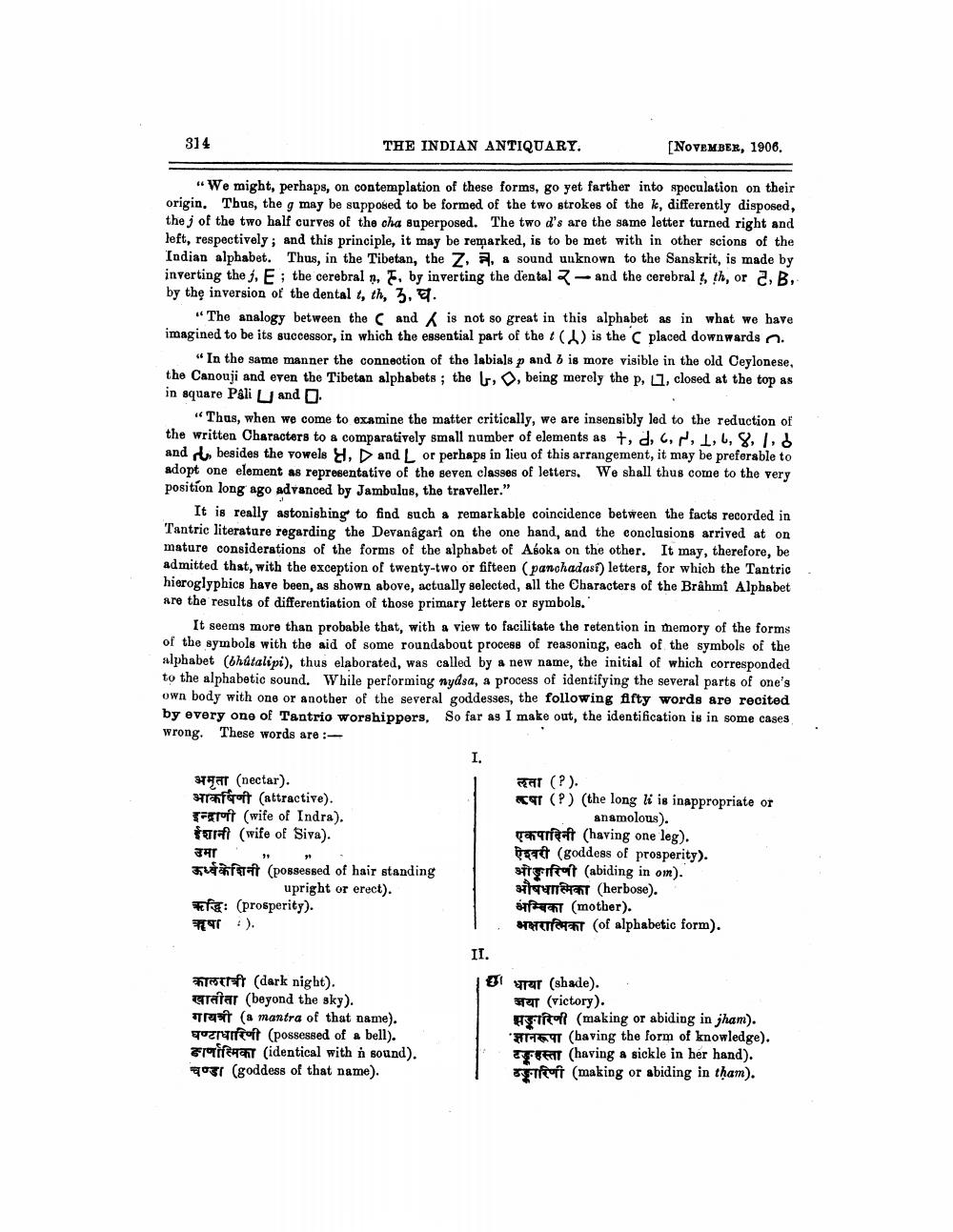________________
314
THE INDIAN ANTIQUARY.
[NOVEMBER, 1906.
"We might, perhaps, on contemplation of these forms, go yet farther into speculation on their origin. Thus, the g may be supposed to be formed of the two strokes of the k, differently disposed, the j of the two half curves of the cha superposed. The two d's are the same letter turned right and left, respectively; and this principle, it may be remarked, is to be met with in other scions of the Indian alphabet. Thus, in the Tibetan, the Z, 2, & sound unknown to the Sanskrit, is made by inverting the j, E ; the cerebral , T, by inverting the dental and the cerebral , th, or a B, by the inversion of the dental 1, th, 3. E.
"The analogy between the and is not so great in this alphabet as in what we have imagined to be its successor, in which the essential part of the () is the placed downwards .
"In the same manner the connection of the labials p and 6 is more visible in the old Ceylonese, the Canouji and even the Tibetan alphabets; the L, , being merely the P, L1, closed at the top as in square Pali and
“Thus, when we come to examine the matter critically, we are insensibly led to the reduction of the written Characters to a comparatively small number of elements as t, d, c, d, 1, 6, 8, 1 d and besides the vowels y, and L or perhaps in lieu of this arrangement, it may be preferable to adopt one element as representative of the seven classes of letters. We shall thus come to the very position long ago advanced by Jambalus, the traveller."
It is really astonishing to find such a remarkable coincidence between the facts recorded in Tantric literature regarding the Devanagari on the one hand, and the conclusions arrived at on mature considerations of the forms of the alphabet of Asoka on the other. It may, therefore, be admitted that, with the exception of twenty-two or fifteen (panchadasi) letters, for which the Tantric hieroglyphics have been, as shown above, actually selected, all the Characters of the Brahmi Alphabet are the results of differentiation of those primary letters or symbols.'
It seems more than probable that, with a view to facilitate the retention in memory of the forms of the symbols with the aid of some roundabout process of reasoning, each of the symbols of the alphabet (bhútalipi), thus elaborated, was called by a new name, the initial of which corresponded to the alphabetic sound. While performing nydsa, a process of identifying the several parts of one's own body with one or another of the several goddesses, the following fifty words are recited by every one of Tantrio worshippers, So far as I make out, the identification is in some cases wrong. These words are :
segar (nectar).
ranfgroft (attractive). Sarit (wife of Indra).
Trafi (wife of Siva). 341 ऊर्ध्वकेशिनी (possessed of hair standing
upright or erect). #g: (prosperity). E :).
car (?). K T (P) (the long li is inappropriate or
anamolous). Tehraft (having one leg). Berat (goddess of prosperity). sitgiftoft (abiding in om).
T (herbose). af (mother). STRIPT (of alphabetic form).
II.
ft (dark night). aralar (beyond the sky). TRA (a mantra of that name). Tartoft (possessed of a bell). ENTITECHT (identical with n sound). 9031 (goddess of that name).
19 yar (shade).
(victory). Hurtoff (making or abiding in jham).
775T (having the form of knowledge). EFFIT (having a sickle in her hand). Erfurt (making or abiding in tham).




